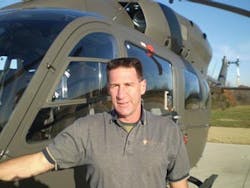Experts Explain
It’s easy to talk about excellence in any profession, let alone the specific area of helicopter maintenance. But what does it take to achieve excellence? To find out, AMT spoke to two exceptional helicopter technicians. One is David Vogel, American Eurocopter’s senior technical representative based in Grand Prairie, TX, and winner of the Helicopter Association International’s (HAI) 2009 Aviation Maintenance Technician Award recipient. The other is Rich Higgins, helicopter crew chief for Cablevision Systems Corp., Farmingdale, NY, and winner of HAI’s 2009 Helicopter Maintenance Award.
Put the customer first
When it comes to being the best in helicopter maintenance, the key is to put the customer first.
“Your customers don’t make money if they can’t keep their aircraft flying,” says Vogel. “So your job, as a helicopter technician, is to do whatever it takes to get them back up in the air when they need to be. After all, your employer won’t make money if you can’t keep your customer flying.”
Putting the customer first translates into action in various ways. From a technician standpoint, it requires careful attention to details at all stages of the repair process; from investigation and diagnosis to parts sourcing, actual hands-on work, and after-repair testing. In terms of project management, putting the customer first affects which parts you keep in inventory for common repairs, and which you ensure are available through fast just-in-time delivery. It also governs how you schedule technicians during off-hours and weekends as well as Monday-Friday 9-5, and how you respond to AOG situations.
Communicate with pilots
“I tell my pilots to talk to me whenever something comes up,” says Higgins. “They can call me at my office, or use my cell. However they do it, I want to know what’s happening as soon as it does.”
Higgins’ suggestion may seem obvious, but the truth is that many repair shops don’t keep in close contact with pilots. Instead, they wait until the helicopter turns up in the hangar before blandly asking why it’s there. This passive attitude wastes time and money for all concerned.
Fix it early
“The key to success is to address problems early,” says Higgins. “If a pilot comes back and says, ‘My hydraulic pressure is fluctuating,’ then that’s the time to look at why this is happening. In the early stages, symptoms can often help you diagnose and fix small problems before they become big ones.”
Fixing problems early is not as easy as it sounds, since helicopters grounded for unscheduled repairs are helicopters unavailable for scheduled service. However, there’s no doubt that dealing with symptoms early means less overall aircraft downtime, and minimizes the number of inconvenient AOG incidents that occur when a component finally fails.
For technicians and their supervisors, sticking to the ‘fix it early’ ethic requires insisting on this point to management. For helicopter owners/operators, reaping the benefits of dealing with problems early requires having extra aircraft available to fill gaps when unscheduled issues first rear their ugly heads.
Be creative, flexible
Remember Higgins’ and Vogel’s insistence on putting the customer first?
It applies to repair shop procedures, and having the chutzpah to do things differently when the situations require it.
A case in point: “We needed a fuel control device that was classified as a hazardous shipment,” Higgins says. “As a result, it couldn’t be sent over the weekend, which is when we needed it. So I sent one of our people on a 20-hour drive to pick the fuel control up, so that the helicopter under repair would be ready to fly on Monday morning as scheduled.
Cablevision’s chairman is very particular about having his aircraft available when he needs them. If this requires adapting how we do things to meet his requirements, we do it.”
Obviously, staying within a repair shop’s budget rules out dispatching staff every time a component is slow to arrive by usual channels. However, there are times when going the extra mile is justified; especially when not doing so will seriously affect the client and, by extension, their attitude toward you. Smart helicopter technicians are willing to get creative and be flexible when necessary. That’s what separates them from everybody else.
Do your paperwork
OK, this isn’t the glamorous part of being an excellent helicopter tech, but it goes with the territory. To be the best, “It is essential to keep up on your paperwork, documentation and filing,” says Vogel. “You also need to take care to store your data on computer such that it can be easily and simply retrieved in the future.”
Accurate, up-to-date paperwork is about more than a tidy desk. It ensures that all repairs are properly documented, all billable hours are charged to the client (thus paying your salary), and that any problems that occur in the future can be properly investigated. It’s good housekeeping, good practice, and a good way to cover yourself when people are shopping for a scapegoat.
Stay current
“Some people think that once they’ve got their A&P, they’ve got all the skills they need,” says Vogel. “That’s not the case. You’ve got to keep training, so that you stay current with new technology and new ways of fixing problems. “
Too true: Someone who got their A&P 30 years ago and has since resisted further training is really not qualified to work on 21st century rotorcraft; no matter how deep their in-shop experience. Technology changes; so does the knowledge of the very best AMTs.
The bottom line
Excellence in helicopter maintenance requires an active, dedicated attitude to all aspects of the craft; driven by a desire to excel and to keep the customer flying. It’s an approach that has taken Rich Higgins and Dave Vogel to their top of their professions, and can do the same for you.
